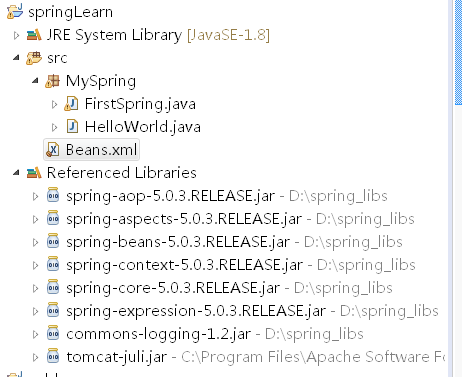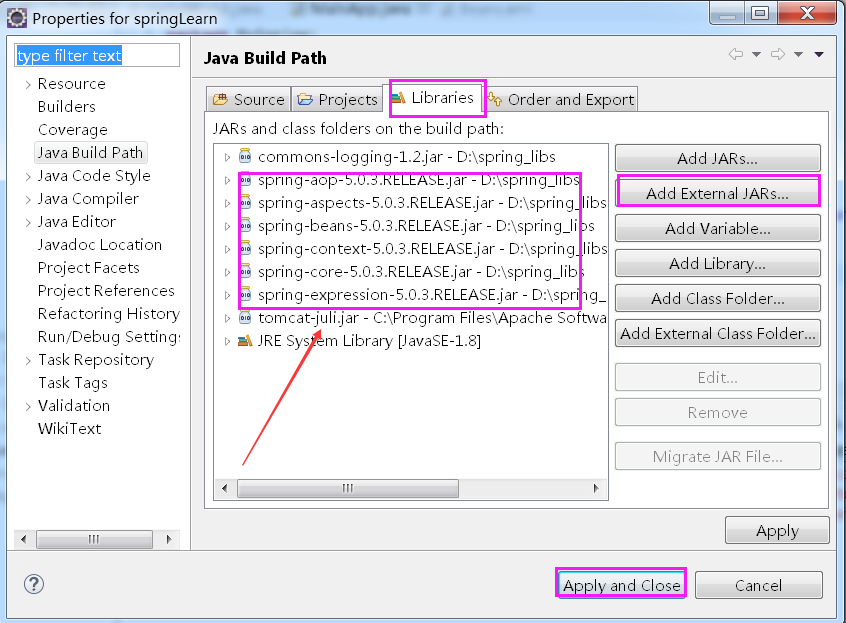通过多天对基础语法的学习,早就向往一睹SPRING的芳容。今天按照ITEYE 唐的 教程,第一次运行Spring成功,步骤及注意事项如下:
一、基础环境
Jdk1.8, Eclipse4.71 、Spring 5.0.3的版本;
Spring 下载地址:http://repo.spring.io/release/org/springframework/spring/
二、详细过程
目录结构及文件

1、在Eclipse中新建项目,点击File----New--- Java Project ,输入项目名称springLearn ,点Finish结束;
2、在src目录上点右键,选new ---Package,新建包,输入包名MySpring ;
3、添加Spring相关jar库文件;
在项目名称上点鼠标,选Build Path---Configure Build Path,点击Add External JARS,打开你的Spring库保存目录,将需要的文件选 上

另外,需要再加载一个commons-logging-1.2的库,下载地址:http://mirrors.tuna.tsinghua.edu.cn/apache//commons/logging/binaries/commons-logging-1.2-bin.zip
添加方法如上;
4、开始编写代码,共有2个文件,都位于MySpring包下(HelloWorld.java 、FirstSpring.java )
HelloWorld.java
1 package MySpring; 2 3 public class HelloWorld { 4 private String message; 5 public void setMessage(String message) { 6 this.message= message; 7 } 8 public String getMessage(){ 9 return this.message; 10 } 11 public void printMessage() { 12 System.out.println("Spring Test:"+message); 13 } 14 15 }
FirstSpring.java文件
1 package MySpring; 2 3 import org.springframework.context.ApplicationContext; 4 import org.springframework.context.support.ClassPathXmlApplicationContext; 5 6 public class FirstSpring { 7 8 public static void main(String[] args) { 9 10 // TODO Auto-generated method stub 11 //使用ClassPathXmlApplicationContext()首先创建一个容器 12 ApplicationContext context= new ClassPathXmlApplicationContext("Beans.xml"); //此处的Beans.xml文件名需与你的配置 文件相同; 13 //然后通过context.getBean()找到这个id的bean,获取对象的引用 14 HelloWorld objTest = (HelloWorld) context.getBean("helloWorld"); 15 objTest.printMessage(); 16 } 17 18 }
关于主要程序有以下两个要点需要注意:
-
第一步是我们使用框架 API ClassPathXmlApplicationContext() 来创建应用程序的上下文。这个 API 加载 beans 的配置文件并最终基于所提供的 API,它处理创建并初始化所有的对象,即在配置文件中提到的 beans。
- 第二步是使用已创建的上下文的 getBean() 方法来获得所需的 bean。这个方法使用 bean 的 ID 返回一个最终可以转换为实际对象的通用对象。一旦有了对象,你就可以使用这个对象调用任何类的方法。
5、编写配置文件,在src目录下,建立Beans.xml文件,文件名可以随意起,但要注意在调用时确保一致;
<?xml version="1.0" encoding="UTF-8"?> <beans xmlns="http://www.springframework.org/schema/beans" xmlns:xsi="http://www.w3.org/2001/XMLSchema-instance" xsi:schemaLocation="http://www.springframework.org/schema/beans http://www.springframework.org/schema/beans/spring-beans-3.0.xsd"> <bean id="helloWorld" class="MySpring.HelloWorld"> <property name="message" value="Hello World!"/> </bean> </beans>
Beans.xml 用于给不同的 bean 分配唯一的 ID,并且控制不同值的对象的创建,而不会影响 Spring 的任何源文件。例如,使用下面的文件,你可以为 “message” 变量传递任何值,因此你就可以输出信息的不同值,而不会影响java文件,不用重新编译。当 Spring 应用程序被加载到内存中时,框架利用了上面的配置文件来创建所有已经定义的 beans,并且按照 标签的定义为它们分配一个唯一的 ID。你可以使用 标签来传递在创建对象时使用不同变量的值。
三、运行程序:
在项目文件上,点右键,选 Run as Application
